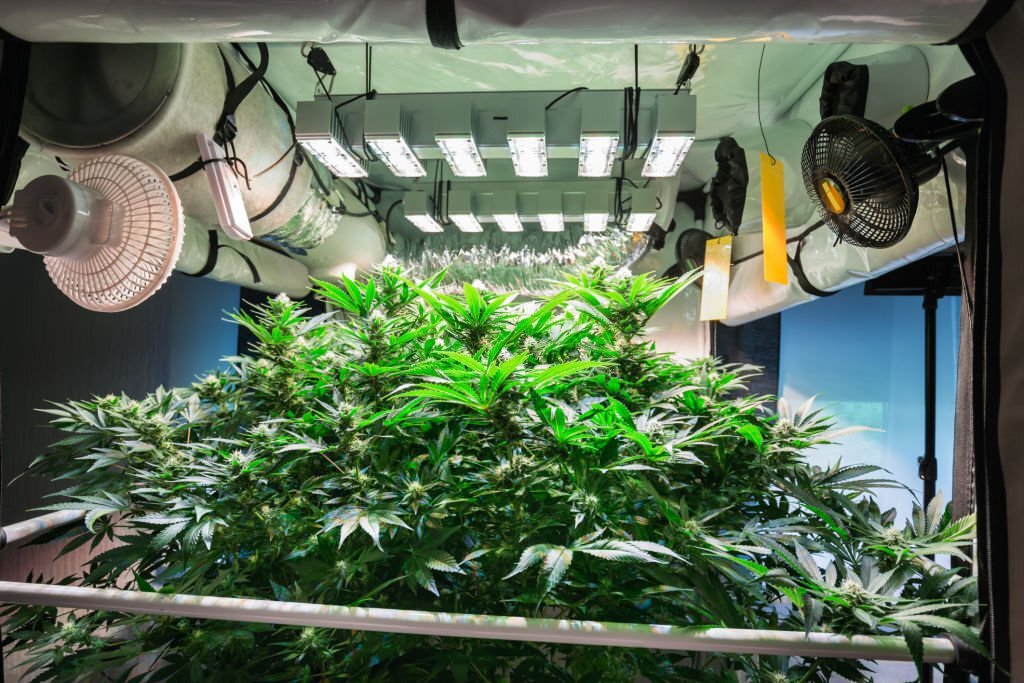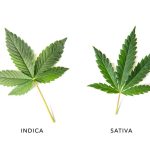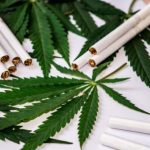🔥 Website for Sale - Contact Us
Growing cannabis at home has become increasingly popular among cannabis recreational and medical marijuana patients. Cultivating a thriving cannabis garden can seem daunting, but with the right grow tent setup, you can achieve impressive results. A well-designed and carefully maintained grow tent can optimize the growth of your cannabis plants, leading to higher yields and better-quality buds.
In this comprehensive guide, we will cover the essential components needed for a high-yielding cannabis garden, ensuring your grow tent setup is tailored to your plant’s needs. From selecting the appropriate grow tent and lighting system to fine-tuning temperature and humidity controls, we’ll dive deep into each aspect of a successful grow tent setup.
II. The Basics of Grow Tent Setup
Before diving into the essential components for a successful grow tent setup, it’s crucial to understand some basic principles that will lay the foundation for your thriving cannabis garden.
A. Choosing the right grow tent size and location
Selecting the appropriate grow tent size is crucial for accommodating your plants as they grow and ensuring they have enough space to flourish. Consider the number of plants you plan to grow, potential size, and available space at home. It’s also important to choose a location with easy access to water and electricity while free from extreme temperatures or ex
cessive moisture.
B. Understanding the importance of proper ventilation and air circulation
A well-ventilated grow tent is essential for maintaining healthy cannabis plants. Proper air circulation in a grow tent prevents the accumulation of heat, humidity, and stagnant air, which can lead to mold, pests, and other issues. Strategically placing fans and vents within your grow tent will help create an ideal environment for your plants to thrive.
C. Selecting the appropriate lighting system
Lighting is a critical factor in the success of your cannabis garden, as it directly influences the growth, development, and overall yield of your plants. There are various types of grow lights available, including HID (high-intensity discharge), LED (light-emitting diode), and fluorescent lights. Each type has its advantages and drawbacks, so it’s essential to research and choose the most suitable option for your specific grow tent setup.
Now that we’ve covered the basics, let’s delve deeper into the essential components that make up a high-yielding cannabis garden within a grow tent setup.
III. Essential Components for a Successful Grow Tent Setup
A. High-quality grow tent
Using a high-quality grow tent is the first step toward creating an optimal environment for your cannabis plants. A well-constructed grow tent will provide a controlled space, allowing you to fine-tune temperature, humidity, and light conditions. Here are some key factors to consider when selecting a grow tent:
Materials and construction
Choose a grow tent made from durable, heavy-duty fabric that can withstand wear and tear. The frame should be sturdy, preferably made of metal, to be able to support the weight of other grow equipment. Make sure the tent has heavy-duty zippers that create a secure seal when closed, preventing light leaks and maintaining a controlled environment inside.
Reflective interior
A grow tent with a highly reflective interior is essential for maximizing light efficiency and ensuring your plants receive an even distribution of light. Mylar is a popular material used for growing tent interiors, as it reflects up to 95% of the light back toward your plants. This reflective surface helps reduce energy costs and increases the overall effectiveness of your lighting system.
By selecting a high-quality grow tent, you’re laying the foundation for a successful cannabis garden. In the following sections, we’ll explore additional components that contribute to a thriving grow tent setup.
B. Lighting solutions
Let’s explore the most popular options and how they can contribute to a successful grow tent setup.
HID (High-Intensity Discharge) Lights HID lights, including metal halide (MH) and high-pressure sodium (HPS) bulbs, have been popular among cannabis growers for years due to their high light output and wide spectrum. MH bulbs are ideal for the vegetative stage, while HPS bulbs are better suited for the flowering stage. However, HID lights generate a significant amount of heat and require additional cooling and ventilation to maintain optimal grow tent temperatures.
LED (Light Emitting Diode) Lights LED grow lights have gained popularity in recent years because of energy efficiency, long lifespan, and broad light spectrum. Many LED lights allow growers to adjust the color spectrum to suit different growth stages, optimizing the light for both vegetative and flowering phases. Although LEDs can be more expensive, they have lower operating costs and produce less heat than HID lights, making them an attractive option for many growers.
Fluorescent Lights Fluorescent lights, such as T5 and CFL (compact fluorescent light) bulbs, are another option for cannabis growers. These lights are energy-efficient and produce less heat compared to HID lights. However, they may not be as powerful or effective as HID or LED lights, making them better suited for small-scale grow, seedlings, or clones.
When choosing a lighting solution for your grow tent, consider factors such as energy efficiency, heat output, and light spectrum to ensure the best results for your cannabis plants. Properly positioning your lights and adjusting the height as your plants grow will also contribute to a successful grow tent setup.
C. Ventilation and air filtration
Inline fans and ducting Inline fans are essential for removing hot, stale air from your grow tent and pulling in fresh, cool air. The size and power of your inline fan should be appropriate for your tent’s size and the amount of heat generated by your lighting system. Ducting should be connected to your inline fan to direct the air in and out of the grow tent. Consider using insulated ducting to minimize noise and heat transfer.
Carbon filters A carbon filter can be attached to your inline fan to scrub the air, removing odors and airborne pathogens. This not only helps maintain a clean environment for your plants but also reduces the risk of unpleasant smells leaking from your grow tent. Replace the carbon filter as needed to ensure continued effectiveness.
Oscillating fans In addition to your inline fans, it’s essential to have oscillating fans inside your grow tent. These fans help to circulate air around your plants, promoting strong stems, and even growth, and preventing pockets of stagnant air. Position your oscillating fans to ensure all plants receive adequate airflow but avoid pointing them directly at the plants to prevent windburn.
In the following sections, we’ll explore other essential components for successful grow tent setups, such as temperature and humidity control, irrigation systems, and growing mediums.
D. Temperature and humidity control
Maintaining optimal temperature and humidity levels in your grow tent is crucial for the health and productivity of cannabis plants. Temperature and humidity Fluctuations can cause stress, slow down growth, and even lead to disease. Here’s how to effectively control temperature and humidity in your grow tent:
Use hygrometers and thermometers to accurately monitor temperature and humidity levels. Place them at various points in your grow tent, such as near the canopy and at the base of your plants, to ensure consistent readings. Regularly check these readings and make adjustments to your grow tent setup as needed.
Heaters and air conditioners can help maintain the ideal temperature in your grow tent, especially during extreme weather conditions. Select energy-efficient models with adjustable thermostats to fine-tune the temperature. Make sure to position these devices in a way that promotes even temperature distribution throughout the tent.
Humidifiers and dehumidifiers help to control the humidity levels in your grow tent, ensuring your plants receive the right amount of moisture at different growth stages. Choose devices with adjustable settings and built-in hygrometers for precise control. Remember to regularly clean and maintain these devices for optimal performance.
By closely monitoring and controlling temperature and humidity in your grow tent, you create a stable environment that promotes healthy growth and maximizes your cannabis yield. In the next sections, we’ll discuss other essential components of successful grow tent setups, such as irrigation and nutrient delivery systems, growing mediums, and plant training techniques.
E. Irrigation and nutrient delivery systems
An efficient irrigation and nutrient delivery system is vital for keeping your cannabis plants well-fed and hydrated. Here are some popular options for managing water and nutrient delivery in your grow tent:
Drip systems
Drip irrigation systems deliver water and nutrients directly to the base of each plant through a network of tubes and emitters. This method allows control over the amount of water and nutrients each plant receives, reducing waste and preventing overwatering. Drip systems can be set up with a timer for automated watering, making them a convenient and efficient option for many growers.
Ebb and flow systems
Ebb and flow (or flood and drain) systems are a popular choice for hydroponic cannabis growers. These systems work by periodically flooding a grow tray with nutrient-rich water, which is then allowed to drain back into a reservoir. This process oxygenates the roots and ensures even nutrient distribution. Ebb and flow systems require a pump, timer, and proper drainage to function effectively.
Nutrient reservoirs and pumps
Regardless of the irrigation method you choose, a nutrient reservoir is essential for mixing and storing your nutrient solution. Select a reservoir that’s large enough to accommodate your grow tent’s water and nutrient requirements. A quality water pump ensures efficient circulation and delivery of the nutrient solution to your plants.
F. Growing medium and containers
Selecting the right growing medium and containers for your cannabis plants is crucial for providing proper support, drainage, and aeration. The choice depends on your preferred growing style, whether it’s soil-based or hydroponic. Let’s explore the options for both mediums and containers:
Soil vs. hydroponic systems
Soil is a traditional growing medium that offers a buffer for nutrients and is generally more forgiving for beginner growers. When choosing soil, look for high-quality organic mixes designed for cannabis cultivation, containing the necessary nutrients and beneficial microbes. Hydroponic systems, on the other hand, involve growing plants without soil, using alternative mediums like coco coir, perlite, or rock wool. Hydroponic systems require more precise nutrient management but can result in faster growth and higher yields.
Fabric pots and air pots
The type of container you choose for your cannabis plants will impact their growth and overall health. Fabric pots, made from breathable materials, promote excellent root aeration and prevent root circling. This encourages a healthy root system and can lead to increased nutrient uptake and plant growth. Air pots, featuring a unique design with holes throughout the sides, also promote root pruning and aeration, leading to healthier plants. Both fabric and air pots are suitable for soil and hydroponic setups, offering improved drainage and overall plant performance.
By choosing the right growing medium and containers for your cannabis plants, you can promote healthy root development and overall plant growth, leading to higher yields. In the next section, we’ll discuss plant training and support techniques that can further enhance the productivity of your grow tent setup.
G. Plant training and support
Plant training and support techniques can significantly improve the productivity and efficiency of your grow tent setup. These methods encourage the growth of multiple main colas, increase light penetration, and create an even canopy, leading to higher yields. Here are some popular plant training and support techniques:
Low-Stress Training (LST)
Low-Stress Training involves gently bending and manipulating your cannabis plant’s branches, guiding their growth to create an even canopy. This technique exposes more of the plant to light, encouraging the development of multiple bud sites. LST can be done using soft ties or plant wire, securing the branches in the desired position without causing damage.
High-Stress Training (HST)
High-Stress Training includes techniques like topping and super cropping, which involve more aggressive manipulation of the plant. Topping involves cutting off the top growth tip of the plant, encouraging the growth of multiple main colas. Super cropping involves pinching and bending branches to create a knuckle, which helps strengthen the plant and increase light penetration. These methods should be done with caution and during the appropriate growth stages to avoid stunting your plants.
Trellising and support nets
Trellising and support nets provide physical support for your cannabis plants, helping to distribute the weight of heavy buds and promoting an even canopy. By weaving the branches through the trellis or support net, you can guide the growth of your plants, optimize light exposure, and increase overall yields.
By employing plant training and support techniques, you can maximize the productivity of your grow tent setup and significantly improve the yield and quality of your cannabis harvest. With all the essential components in place, you’ll be well on your way to cultivating a thriving and high-yielding cannabis garden within your grow tent.
IV. Monitoring and Maintaining Your Grow Tent Setup
Regular monitoring and maintenance are crucial for ensuring the ongoing success of your grow tent setup. By keeping a close eye on your plants and equipment, you can address potential issues in their tracks. Here’s what to consider when monitoring and maintaining your grow tent setup:
Daily inspection Inspect your cannabis plants daily for any signs of stress, pests, or disease. By catching issues early, you can take swift action to remedy the situation and minimize any negative impact on your plants. Environmental conditions Continuously track temperature, humidity, and light conditions within your grow tent. Make adjustments as needed to ensure your plants receive the optimal environment for their growth stage. Regularly recalibrate any sensors or measuring devices to ensure accuracy in your readings.
Equipment maintenance
Maintain your equipment by cleaning and servicing it as per the manufacturer’s guidelines. This includes cleaning or replacing air filters, checking the integrity of your grow tent fabric and zippers, and ensuring all electrical connections are secure.
Nutrient and pH management
Regularly monitor the nutrient concentration and pH levels of your growing medium or hydroponic system. Adjust your nutrient solution as needed to maintain the optimal balance for your plants. Regularly flush your growing medium or hydroponic system to prevent the buildup of salts and other undesirable compounds.
Record-keeping
Keep a detailed log of your grow tent activities, including environmental conditions, nutrient and pH levels, and any plant issues or treatments. Record-keeping helps identify patterns, track your progress, and make data-driven decisions to improve your grow tent setup.
V. Maximizing Your Cannabis Harvest
After investing time and effort into setting up and maintaining your grow tent, it’s essential to focus on maximizing your cannabis harvest. Here are some tips to help you maximize your harvest:
Choose high-yielding strains
Select cannabis strains known for their high yield and potency. Research and choose strains that are well-suited to your grow tent environment, taking into consideration factors such as growth habits, flowering time, and disease resistance.
Optimize lighting
Ensure that your cannabis plants receive optimal light exposure by adjusting the height and position of your grow lights as needed. Maintain a proper distance between the lights and the canopy to avoid light burn, and rotate your plants regularly to ensure even light distribution.
Implement advanced training techniques
In addition to the basic plant training techniques discussed earlier, consider implementing advanced methods such as SCROG (Screen of Green) or SOG (Sea of Green) to further optimize the light penetration and create an even canopy, resulting in increased yields.
Focus on nutrient management
Maintains a balanced nutrient regimen tailored to your plant’s needs and growth stages. Regularly monitor and adjust the nutrient concentration and pH levels to ensure optimal uptake and avoid nutrient lockout or deficiencies.
Maintain a clean and pest-free environment
Keep your grow tent clean and free from debris to minimize the risk of pests and diseases. Implement Integrated Pest Management (IPM) strategies, such as introducing beneficial insects or using organic pesticides, to control pests without harming your plants.
Harvest at the right time
Harvest your cannabis plants when they are at their peak maturity to ensure maximum potency and yield. Monitor trichome development and color changes to determine the ideal harvest window for your specific strain.
By implementing these strategies, you can maximize the potential of your grow tent setup and enjoy a bountiful cannabis harvest. With dedication and continuous improvement, you’ll become a more skilled and successful cannabis cultivator.
VI. Conclusion
Setting up a successfully grow tent for your cannabis garden involves careful planning, attention to detail, and ongoing maintenance. By selecting the right equipment and implementing effective growing techniques, you can create an optimal environment that supports healthy plant growth and maximizes your harvest.
Remember to focus on the essential components of a successful grow tent setup: high-quality grow tents, appropriate lighting solutions, proper ventilation and air filtration, temperature, and humidity control, efficient irrigation, and nutrient delivery systems, suitable growing mediums and containers, and effective plant training and support techniques.
Regular monitoring and maintenance are crucial for the ongoing success of your grow tent, and by implementing strategies to maximize your harvest, you can enjoy the rewards of your hard work.





